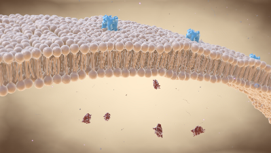Phospholipid Assay Kits
Phospholipids are amphiphilic molecules with both hydrophilic and hydrophobic parts. As major components of cell membranes, phospholipids play important structural and functional roles. Phospholipids are also components of lipoproteins, contributing to the stabilization of lipids in the blood, are required for the synthesis of cholesterol esters, and play an important role in lipid metabolism. By examining the phospholipids in the blood, the state of liver function and related conditions can be assessed.
LabAssay™ Phospholipid is based on an enzymatic colorimetric method using the Trinder reagent (choline oxidase-DAOS method). Because it uses phospholipase D, endogenous triglycerides, free glycerol, or inorganic phosphate do not significantly affect the assay. With the use of the enzymes, this kit provides a convenient method for measuring phospholipids (lecithin, sphingomyelin, lysolecithin) in a microplate format.
What is Phospholipid?

Phospholipids are amphiphilic molecules with both hydrophilic and hydrophobic parts. As major components of cell membranes, phospholipids play important structural and functional roles. Phospholipids are also involved in various functions, including the emulsification and absorption of fats, blood clotting, acid-base balance, and choline metabolism1).
Phospholipids have a structure in which fatty acids and a phosphate group are bound to alcohols such as glycerol or sphingosine. Those with a glycerol backbone are called glycerophospholipids, while those with a sphingosine backbone are called sphingophospholipids. The figure below shows lecithin (phosphatidylcholine), a type of glycerophospholipid that makes up 30-50% of the phospholipids in cell membranes. The main phospholipids in serum are lecithin (phosphatidylcholine), sphingomyelin, cephalin (phosphatidylethanolamine), and lysolecithin (lysophosphatidylcholine) in a ratio of approximately 68:19:5:81). These phospholipids are involved in many physiological processes affecting human health, such as lipid abnormalities, inflammation, cancer, immune system, nervous system, and liver function. In addition to their functions within the body, phospholipids have attracted attention for their applications as emulsifiers, surfactants, liposomes, and more.

Figure 1. Structure of lecithin (phosphatidylcholine)
Phospholipids, as components of lipoproteins, also contribute to the stabilization of lipids in the blood, are necessary for the synthesis of cholesterol esters, and play an important role in lipid metabolism. Phospholipid levels in the blood change in a similar manner to cholesterol, and the state of liver function and related conditions can be assessed by examining the phospholipids in the blood.
Methods of Phospholipid Measurement
LabAssay™ Phospholipid is based on an enzymatic colorimetric method using the Trinder reagent (choline oxidase-DAOS method). Because it uses phospholipase D, endogenous triglycerides, free glycerol, or inorganic phosphate do not significantly affect the assay. With the use of the enzymes, this kit provides a convenient method for measuring phospholipids (lecithin, sphingomyelin, lysolecithin) in a microplate format.
Principle of the phospholipid assay using the choline oxidase-DAOS method
Phospholipids in the sample (lecithin, sphingomyelin, lysolecithin) are hydrolyzed by phospholipase D, releasing choline. The resulting choline is then oxidized to betaine by choline oxidase, simultaneously producing hydrogen peroxide. The resulting hydrogen peroxide induces oxidative condensation of 4-aminoantipyrine and DAOS through the action of peroxidase (POD), producing a blue dye. The absorbance of this blue dye is measured to determine the concentration of phospholipids in the sample (Figure 2).

Figure 2. Principle of the phospholipid assay using the choline oxidase-DAOS method
LabAssay™ Phospholipid
LabAssay™ Phospholipid is a kit used for the determination of phospholipids in samples using the choline oxidase-DAOS method. With the use of a microplate, this kit provides a quick and convenient method for measuring phospholipids in samples.
[Note] LabAssay™ series are reagents for research purposes. They cannot be used for diagnostic purposes.
Kit Performance
| Analysis sample | Human Serum/Plasma Mouse Serum/Plasma Rat Serum/Plasma Dog Serum/Plasma Cat Serum/Plasma Culture medium (D-MEM)* |
|---|---|
| Calibration curve range | 75.0-596.1 mg/dL |
| Sample volume | 2 μL |
| Measurement duration | Approx. 10 min |
| Wavelength | Primary wavelength 600 nm Reference wavelength 700 nm |
*It is tested by using the samples that standard substances have been added to the culture medium.
Measurement availability depends on the culture medium, cell type and culture conditions. When using cell culture supernatant as a sample, please perform a spiked recovery test or dilution linearity test in advance using the culture medium to be used in your experiment.
References
- Okumura, N., Tozuka, M., Honda, T. and Yatomi, Y.: "Manual of Clinical Laboratory Medicine 35th ed.", Kanehara shuppan, (2010). (Japanese)
Product List
- Open All
- Close All
LabAssay™ Phospholipid
For research use or further manufacturing use only. Not for use in diagnostic procedures.
Product content may differ from the actual image due to minor specification changes etc.
If the revision of product standards and packaging standards has been made, there is a case where the actual product specifications and images are different.
The prices are list prices in Japan.Please contact your local distributor for your retail price in your region.



